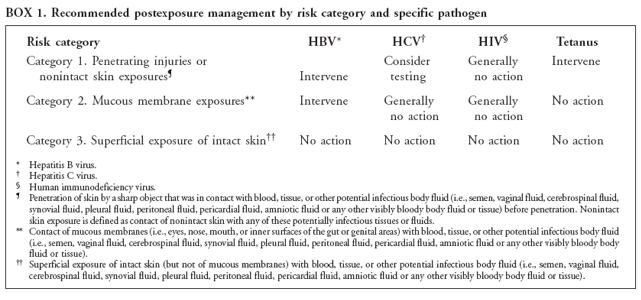An ongoing dialogue on HIV/AIDS, infectious diseases,
April 20th, 2013
Postexposure Prophylaxis (PEP) After Blast Injuries
From a colleague came this query:
We are being consulted by surgeons who are finding within blast victims tissues from other humans. We have been offering post-exposure prophylaxis. Have you folks developed any policies re PEP for explosion victims?
Welcome your thoughts,
P
Needless to say, the bombing victims are currently facing far greater challenges than exposure to blood-borne pathogens. But it’s a very reasonable query and, as it turns out, there’s an existing guideline that addresses the issue, published in MMWR in 2008.
Entitled “Recommendations for Postexposure Interventions to Prevent Infection with Hepatitis B Virus, Hepatitis C Virus, or Human Immunodeficiency Virus, and Tetanus in Persons Wounded During Bombings and Other Mass-Casualty Events” — MMWR has a real knack for titles — it’s a valuable resource for a a very tricky clinical problem. It appropriately starts by stating that “Decisions regarding the administration of prophylaxis after a mass-casualty event are complex,” then goes on to make the the following recommendations:
So in general, post-exposure prophylaxis for HIV is not recommended after bombings or other mass casualty events.
Still, the fine print does say it might be recommended in certain situations. One could imagine blast injuries in very high prevalence settings (Sub-Saharan Africa, certain urban areas in the USA) meeting this threshold.
Remember also that these were published in 2008, and at that time one major factor in the decision to withhold PEP was the toxicity of the intervention, which was zidovudine/lamivudine plus lopinavr/ritonavir. Today, with TDF/FTC and raltegravir the new standard of care, PEP is far better tolerated. (See here for the excellent New York PEP guidelines.)
So the bottom line? In grisly settings such as the one described in the above email — tissue of other humans embedded into humans — giving PEP is certainly defensible, guidelines notwithstanding.



No idea why the updated PEP guidelines from CDC have not seen the light of day? These 2008 recommendations are OLD and, as you say, outdated. People should look at the NY Department of Health updated guidelines which are excellent.
Carlos, completely agree. Have added a link to the NY recs in the post.
Paul
Thanks, Dr. Sax. This is informative and a sobering topic to consider. Sending best wishes to you and your colleagues in the Boston vicinity.
Its basically a matter of the experiance of exposures to mass casualities in crowded settings , where no body knows the status of other people and its a mess like situation with blood and sharps all over, to date we don’t know about any case report of acquiring HIV in such events but my feeling is its never followed in any event so far, i think if the prevalance of the disease is higher in an area i will favor PEP, if its low or all the patients are registered in some national health data base and every thing is known than the situation is different.